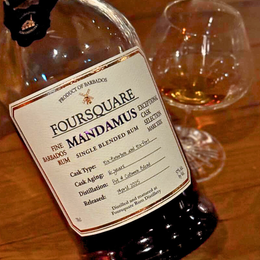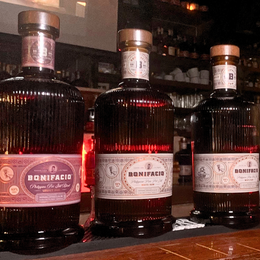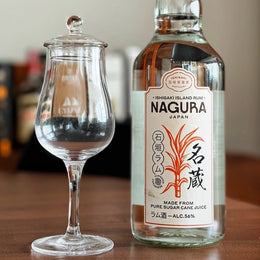
Over the last decade, rums have certainly gained increasing popularity; what was once arcane, poorly understood, decidedly marked out for mixer-use only has become an invitation for junkies to explore the universe of the cane: a fun game-world of gems to be discovered and mythical vintage bottles to be collected. It’s gotten a lot more fun, that’s for sure.
We could point to a whole host of catalysts that eventually culminated in bringing this age-old beverage to the spotlight – and yet we can’t have this conversation without talking about the cultural significance of Luca Gargano’s work at Velier. Now I’m not a fanboy by any means, but give the man credit where it’s due – when was the last time you or I managed to take something that’s existed for centuries and got the whole world drinking it again as if it was just some fresh, newly discovered Kombucha?
Much in the lineage of Silvano Samaroli, Luca was able to get the world to take the Caribbean spirit seriously by helping to formalise its standards, introducing greater transparency and learning to appreciate the spirits as they are produced – single, pure and able to stand on their own. These were not the stuff you’d mix in Daiquiris and they should feel no shame nor pressure to hide behind the veil of an opaque blend. They were to be understood in and of themselves – the good, the great and certainly, the nasty bits.


Where bad rums are banished to. (Image Source: RecipeTin Eats)
Much like Samaroli, Luca too made a name of bottling cask strength or full proof spirits. This all seems very colloquial in the language we now throw about as rum and malt maniacs and we take that for granted. But let’s unpack this a little – a rum that is bottled at full proof is akin to a singer standing solo on the stage with strobe lights shining down on him or her – everything is on display for all to see. Such a rum must be able to confidently hold its own, and be unabashedly itself – the good, the great and certainly, the nasty bits. Such a strong statement of confidence it was for Luca to have introduced the world to full proof rum when it was busy sipping on 2 parts rum, 1 part lime juice and ¾ part sugar syrup, and oh boy, a whole lot of crushed ice.

Some of the greatest hits. (Image Source: Rum Auctioneer)
It worked! And since, we’ve now expanded our vocabulary to include the ever-revered Caronis, the so-loved Demeraras, and the wildly popular Hampdens. These have come to be considered mandatory reading (or should I say tasting) material for anyone who wants to seriously comprehend rums. I’m not a Luca/Velier fanboy, but boy his positive influence cannot be understated. It was on full proof rums and a small little outfit he had acquired and named Velier, that Luca made a name for himself.
Yet, as we all happily trod along on our happy adventures through this new world of rum exploration, taking our palates island-hopping if you will, few will remember this label – it reads: “1980 Full Proof 60,3° Rhum Damoiseau”. Decked in a tan cardboard carton, with the text unevenly distributed, plastering the entire front face of the box, to be read top to bottom, only to be intersected by an image of a local lady from Guadeloupe, finally ending with a logo with the text “Damoiseau” in italics and the classification “Planteurs en Grande Terre GUADELOUPE”. It looks nothing remotely like what we’re used to in our journeys through tasting what the Caribbean has to offer.
And yet – what if I told you that this was where it all started? This was Luca and Velier’s first entry into the rum world’s full proof era.

Not the Velier uniform you're used to. (Image Source: Rum Auctioneer)
Now, the peculiarity of this bottle does not cease at its appearance, completely foreign to the Velier bottlings we’ve come to look out for. This bottle has a twin. As the literary tropes for twins go – there’s a good twin and an evil twin.
So, the story goes (as Cyril of DuRhum discovers) that Luca was journeying through the Caribbean when he chanced upon the distillery Damoiseau on the island of Guadeloupe. Upon tasting, he found the rum to be outstanding and enquired about it. He would then be informed that the distillery has an excess of rums that year as they did not meet origin control standards – it had a small component of molasses rum when instead the INAO (National Institute of Designation of Origin) had prescribed rums from Guadeloupe to be solely made from pure sugar cane juice.
Now, it would seem like the hands of fate had clapped and Luca was the only one there to hear it – he purchased the 1980 vintage rum at 60.3% and would later transfer it to a foudre (an inactive wooden container that allowed the rum to rest and halted its evolution). Four years later, Velier would introduce to the world “1980 Full Proof 60,3° Rhum Damoiseau”.

The Damoiseau Distillery in Guadeloupe. (Image Source: Surf and the City)
Here’s the twist, Luca would later discover that his piece-de-resistance was not singular – it turned out the Damoiseaus (the family that founded and operated the Damoiseau Distillery, sometimes also known as Bellevue) had not actually kept to their agreement to sell the entire stock of 1980 vintage Damoiseau rums to Luca. This was discovered when the distillery began marketing Damoiseau-branded bottles carrying the same vintage and even proof. Call it the bad twin, I suppose? Calm down, I know a couple of nice twins. They’ve approved this message.

The most cheesy evil twin plot in rum history? (Image Source: DuRhum)
Yet, to hammer further down on a cheesy twin-based literary plot twist, the twins had started out identical, gone their own paths and landed with different circumstances. Somewhat. The two 1980 vintage Damoiseau rums may have started out equal, but were not bottled the same. Remember the foudre? It turned out that the Damoiseau-branded rum, while distilled in 1980, would be aged for 18 years before being bottled in 1998, meanwhile, Velier’s Damoiseau was bottled in 2002, making it technically 22 years old - it has 4 more years under its belt, during which it rested in the foudre (which supposedly had no influence on the distillate).
Without further ado – the start of the full proof era of rums.

Velier’s 1980 Full Proof 60,3° Rhum Damoiseau – Review
Colour: Dark Mahogany. The colour of Coca-cola soda poured into a glass.

Early thoughts on the nose bring to mind a cozy, aromatic French bakery. Rich, sweet and perfumery. (Image Source: Mashed)
On the nose: Very deep and yet mellow in equal parts. Its aroma is very perfumery and fragrant but at the same time it is nowhere sharp nor pungent. It has a self-assured quality that awaits your approach (rather than it coming towards you) – which is an interesting olfactory complexity worth mentioning. The aromas fall within the realm of baked goods – vanilla pods, cinnamon sugar, figs, rose water, jasmine flowers, mandarin peels. Delightful, dangerously approachable.

More rich base notes show up. (Image Source: Know Your Grinder, El Camino Health, Cigar Journal, No-Frills Recipe)
More aromas slowly unveil themselves, ground espresso bits, honey, lots of treacle and light touches of tobacco leaf. There’s an oily quality about it that I would categorise as butter, alongside some herbal jelly, wheatgrass and this touch of burnt and musty rubber.

And... a touch of dusty tire? (Image Source: PIXNIO)
The slew of base notes while all very sweet and fragrant, with an incredibly deep and long-drawn out scent – the aromas go on longer than you could take as deep a breath – would fall short only for coming across as a little one-dimensional and predictable.
On the palate: A great rounded body, buttery mouthfeel that is almost chewy. Initial notes are rather straightforward. There’s more of the baked goods from where they came from – cinnamon sugar, orange zest, treacle-like sweetness and texture. The same potpourri of florals, of dried roses, jasmines, lavender, black tea leaves, some cedar and quite musky. More simple syrup, dried mixed fruits, apricots, raisins and some more herbal grassiness.

More baked goods. (Image Source: Like Mother, Like Daughter, Substitute Cooking, Wallpaper Flare, The Guardian)
This placid lake of predictable expectations is stirred up when, as the dried fruits and spices begin to fade, umami and salty notes begin to appear. There’s almost dried salted fish and aged parmesan – piquant, lively ingredients that usually bring pungency yet have been carefully integrated here as a pleasant, savoury core . Some dried nutty bitterness show up as well, reminding me of almonds and peanut shells.
 Suddenly BAM! Umami bomb! (Image Source: Nofima, Lovefood)
Suddenly BAM! Umami bomb! (Image Source: Nofima, Lovefood)
This is a marked deviation from what was experienced earlier, and I’m not entirely sure these two dimensions of flavour complement one another, but the overwhelming treacle sweetness seems to smoothly glide over and fill the cracks. Also, where is the heat and punchiness? The flavours are so intense and for the most part delectable, that the heat is buried and you almost forget that this is 60.3% full proof!

Textbook Rhum Agricole treacle, bitter nuttiness, and grassiness. (Image Source: The Spruce Eats, Wikitionary, Healthline)
The finish is very long and ever expanding, the aromas continue to permeate as you’re left with more treacle, slight twangs of bitter nuttiness and the same bright grassiness. It fades with a slight astringency and drying quality that is somewhat oaky and tannic.
My Take
Dangerously drinkable stuff this is! It is lively, tasty and approachable with great classic flavours of sweet treacle that develops to perfumery dried florals and herbs, before evolving into some more interesting flavours of oak musk and salty umami granules. Texturally it is as its flavours are – very moreish and meaty, full-bodied and syrupy. On the whole, it could be best described as being very big, bold but balanced.

A big figure carries with him a big target on his back. When we enjoy the easily accessible Velier rums today, how much can we separate the man from the rum, both us and Luca's Velier. (Image Souce: Les Caves du Roy)
Although it embodies the virtue of “simple things done well” – my honest assessment is that it is quite a plain sailing journey without too many exciting plot twists. Is it good? Most definitely. Is it as legendary as its reputation that precedes it today? Not exactly. It is a superb-tasting rum and one of cultural significance, and must definitely be included in the annals of rum history and every rum aficionado’s required tasting list. Yet, we should not forget that while this bottle marks the start of an era, it does not singlehandedly represent the full tapestry of this rich era. Its canonisation is not purely its own work, but the joint efforts from multitudes of remarkable full proof Velier rums that were to come thereafter. But, make no mistake, the quality of the subsequent bottlings takes nothing away from the significance of this old bottling.
My Rating |
🤤 🎯
This was some damn tasty stuff - great textbook rhum notes, nice, warm, cozy. Nothing fancy, just goes straight for the target. Its cultural significance of course cannot be understated and maybe I'm spoilt by all the great stuff that came after it - but kinda wish it had more jazz hands y'know? |
I want to end with a coda on how Velier’s releases are perceived today.
Fans of the rap genre may be familiar with a noteworthy album by one very bombastic DJ Khaled, titled “Suffering from Success”, which unironically features the rapper grasping his head in the palm of his hand, presumably suffering from his success-induced migraine. To my mind, Luca and Velier ain’t too far off from this portrait.

For the uninitiated, I'm about to gift you one of the most laughable byproducts of the mainstream pop culture. You can't un-see this. (Image Source: Amazon UK)
We often forget that Luca’s work has significantly raised the profile of rums and had helped to create a world conducive for rum explorers like myself, possibly even expanding the world by drawing in new enthusiasts. Unfortunately, his continued success has made him a bigger target for criticism. With someone whose work is as widely patronised as Luca’s, it gets increasingly difficult to obtain unanimous consensus from the wider rum world on the unshakable quality of every bottle from Velier. The cost of being in the constant limelight is that Velier can no longer please all of us. We no longer see things as they are, but see things as we are.

Last look, since I couldn't nab it home.
Yet, should you ever need a reminder of the importance of Luca’s work, just go back and pour yourself a dram of the OG: the 1980 Full Proof 60,3° Rhum Damoiseau. You won’t be thinking Daiquiris, I assure you.
PS. I look forward to my date with its “evil” twin.
Kanpai!

@111hotpot







